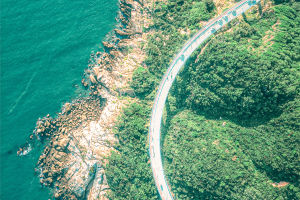Terracing is an agricultural cultivation technique that involves using smaller sloped areas to create larger cultivated areas by arranging terraces in a stepped manner on a hillside at equal heights, forming parallel terraced platforms.
Terraces are widely used throughout Asia, particularly in southern China. The extensive use of terraces reflects people's ability to adapt to nature and their awareness of environmental protection, representing the essence of ancient agricultural technology.
The history of terraces dates back to ancient times when they not only provided abundant food and vegetables but also contributed to environmental preservation. In the mountainous regions of China, terraces became essential for the livelihoods of people.
Ancient Chinese communities have long relied on terraced fields to cultivate various crops. Moreover, terraced fields aid in soil and water conservation by incorporating terraced canals that separate the fields.
These canals help retain rainwater, creating reservoirs that prevent water from drying up. The combination of natural features in terraced fields, such as mountain streams, forests, and water systems, paints a vibrant picture of life.
Terraces offer excellent ecological functions. Rice, the predominant crop in terraces, requires ample water and nutrients. The suitable light and humidity conditions in terraces allow for water pooling, resulting in better utilization of water resources.
Additionally, other crops like beans and corn can be grown on the terraces, significantly enriching farmers' lives with nutritious food and making substantial contributions to local economic development.
Beyond water conservation and enhancing farmers' livelihoods, terraces have long-lasting ecological effects. Terraces stimulate the land's potential, making it suitable for agricultural production.
Over years of cultivation, fertile land is nurtured, leading to increased greenery in the mountains. This microclimate environment helps regulate temperatures and mitigates natural disasters such as floods and mudslides.
Terraced landscapes in Japan, classified as national treasures, not only represent agricultural culture but also serve as tourist attractions. Kyoto, a renowned tourist city in Japan, boasts breathtaking terraced landscapes.
Terraced rice fields have consistently inspired artists and photographers, captivating them with the rhythmic patterns and changing colors of the fields. Moreover, terraces are integral to cultural heritage, with their complex relationship with agricultural, social, and cultural aspects throughout history warranting further study and preservation.
However, as agricultural technology has advanced, the demand for terraces has shifted. Traditional terracing methods often require significant human and material resources, while modern agricultural techniques offer more efficient and cost-effective crop cultivation methods, leading to abandonment of terraces in some areas.
Therefore, the conservation and development of terraces necessitate continuous reflection and exploration.
Terracing initially emerged as a method for people to adapt to nature. Compared to modern cultivation methods, terracing prioritizes environmental protection and natural harmony, employing sustainable practices to maintain the Earth.
While cultivating, it is crucial to adhere to the laws of nature, striking an ecological balance to achieve sustainable development. Consequently, in today's society, it is the responsibility of each individual to protect and advocate for terraces, starting with small actions, fostering love and care for the environment and nature.
To safeguard terraces, a series of measures should be implemented. Propaganda and education efforts must be strengthened to raise awareness about the importance of terraces and integrate traditional terraced cultivation methods into modern agricultural concepts.
Policy support should be enhanced, including increased investment in restoring and maintaining terraces, encouraging and supporting farmers to cultivate diverse crops, and developing relevant incentive and subsidy policies.
Furthermore, international cooperation should be fostered to introduce and learn from advanced ecological agriculture technology and experiences from the West, aiding in the better protection and development of terraces.


